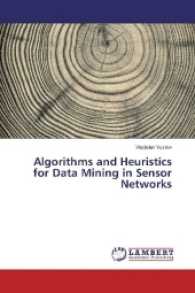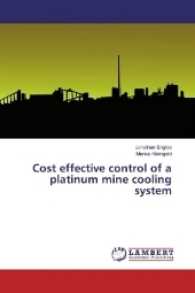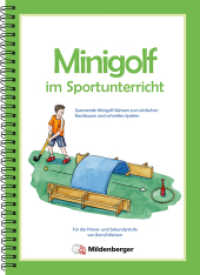基本説明
Why do research on families? What are the stages of social research? What are the benefits of well-conducted research? How is research analyzed? How are literature searches and reviews conducted? How is the Internet best used in research?
Full Description
Proud sponsor of the 2019 SAGE Keith Roberts Teaching Innovations Award—enabling graduate students and early career faculty to attend the annual ASA pre-conference teaching and learning workshop.
In the 3rd edition of Methods of Family Research, authors Theodore N. Greenstein and Shannon N. Davis continue to help students better understand the research results they encounter in doing family research. Using real-life examples to illustrate important concepts that family researchers encounter regularly, the text covers traditional quantitative methods, qualitative methods, and the mixed-method approach. Written in a clear, concise style, this book differs from other research methods texts, which focus on teaching students how to produce research, by teaching them how to consume research in a sophisticated, effective manner. The book introduces the basic concepts of social science research methods without excessive technical details.
Contents
Preface
The Goal of This Text
What's New in the Third Edition
To the Student
To the Instructor
Organization of This Text
Acknowledgments
1. Why Do Research on Families?
What Are the Stages of Social Research?
How Is Research on Families Different?
The Benefits of Well-Conducted Research
Study Questions
For Further Reading
2. Causal Inference in Family Research
Variables
Units of Analysis
Thinking Causally
Framing the Hypothesis
Causal Inference in Qualitative Research
Study Questions
For Further Reading
3. Searching and Reading the Literature
Reading a Journal Article
Where Do I Go From Here?
How Do Journal Articles Get Published?
Research Monographs
Edited Volumes
Other Types of Publications
Study Questions
For Further Reading
4. Sampling Issues
Defining the Population
Sampling Designs
How Large Does the Sample Need to Be?
How Do We Go About Choosing a Sampling Technique?
Study Questions
For Further Reading
5. How Do We Measure Concepts?
Characteristics of a Good Measurement Procedure
Levels of Measurement
What Are Reliability and Validity?
Some Thoughts on Reliability and Validity
Study Questions
For Further Reading
6. Working With Scales and Indices
Types of Scales and Indices
Using Existing Scales and Indices
How Do We Evaluate Scales and Indices?
How Do We Deal With Missing Data in Scales and Indices?
Study Questions
For Further Reading
7. Studying Families: Quantitative Methods
Studying Families Through Experiments
Studying Families Through Survey Methods
Studying Families Through Nonreactive Techniques
Types of Nonreactive Research
Secondary Analysis of Sample Surveys
Some Limitations of Quantitative Methods
Study Questions
For Further Reading
8. Studying Families: Qualitative Methods
Qualitative Research Compared to Quantitative Research
Types of Qualitative Strategies
Studying Families through Observation
Evaluating Qualitative Research
Study Questions
For Further Reading
9. Studying Families: Mixed Methods
Mixed-Method Approaches to Family Research
Mixed-Model Studies in Family Research
Some Closing Thoughts on Choosing a Research Strategy
Study Questions
For Further Reading
10. Using Other People's Data
Advantages and Disadvantages of Secondary Analysis
What Are Some Sources of Data About Families?
Sources of Secondary Data Sets
Future Trends in Secondary Data Analysis
Study Questions
For Further Reading
11. Analyzing Data on Families
Descriptive Statistics
Interpreting Cross-classification Tables
Inferential Statistics
Commonly Reported Tests of Statistical Significance
Some Thoughts About Statistical Analysis
Study Questions
For Further Reading
12. Advanced Topics in Family Analysis
The Idea of Nested Entities
Analyzing Nested Data
Individual Change over Time
Final Thoughts on Nested Entities
Study Questions
For Further Reading
13. Evaluating Family Programs
Needs and Social Impact Assessment: What Is the Problem?
Outcome Assessment: Does It Work?
Process Research: How Does It Work?
Some Thoughts About Randomization in Evaluation Research
The Relationship Between Applied and Basic Research
Study Questions
For Further Reading
14. The Ethics and Politics of Family Research
Ethical Issues in Research on Families and Children
What Is the Role of the Institutional Review Board?
Political Concerns in Research on Families
Some Closing Thoughts
Study Questions
For Further Reading
References
Glossary and Index
About the Authors








